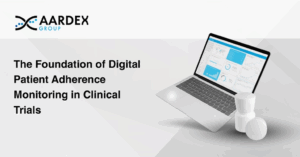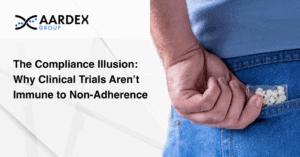The World Health Organization (WHO) has recently highlighted how poor adherence can lead to poorer outcomes for prisoners, contributing to health inequalities the world over. But it is worth noting that near-perfect adherence can be just as troublesome within the current drug development landscape.
With medication administration being almost compulsory behind bars, people can fall into the so-called “compliance trap” as they start taking their medications as prescribed. It is dangerous and potentially toxic – and it all begins in clinical trials.
World Patient Safety Day1
As part of its 2022 World Patient Safety Day, WHO highlighted medication non-adherence as one of the primary sources of medication harm across the criminal justice system.
Referring to the three quantifiable phases of adherence – initiation, implementation, and discontinuation – the body said there were “specific characteristics of the prison environment and the interlinks with the healthcare system that have a role to play” in each.
Barriers to treatment initiation, for example, may include a lack of access to medicines and limits on the prescribing rights of prison physicians. And stigmas, such as that surrounding conditions including hepatitis C virus (HCV) and human immunodeficiency virus (HIV), can sometimes prove to be a barrier to treatment implementation, defined as the maintenance of the prescribed dosing regimen. For instance, prisoners who do not want their medical condition to become common knowledge may miss or refuse doses.
Treatment discontinuation post-detention also represents a considerable problem in this setting. People who may have been receiving treatment for HCV, HIV, or opioid use disorders, for example, frequently stop taking their medicines upon regaining their freedom, often due to a lack of access to community healthcare.
This only compounds health inequalities and contributes to poorer outcomes for current and ex-prisoners alike.
Imperfect implementation2
But looking at medication adherence in prison raises another significant issue surrounding medicine-taking behavior – the consequences of unnecessary dose escalation.
In 2018, correctional medicine physician Jeffrey Keller, MD, wrote an article describing what he called “the compliance gap.” “What I mean by this is that inmates are much more compliant with taking their medications when in jail than when they are at home. This often results in important medical consequences – patients can get hurt,” he wrote.
When an inmate arrives in jail, he explained, the prison will endeavor to continue their medications as they were prescribed “on the outside.” Adherence is strictly monitored, and any missed doses are logged and quickly followed up with a nurse intervention. The result is in-jail adherence rates of 90% or higher. This is far above the barely 50% often seen in clinical practice.
“This, then, is the compliance trap. Jail patients are compliant with their medications in a way that they were not before coming to jail, which can sometimes get them into trouble,” said Dr. Keller.
One patient, with a pre-existing prescription for 600mg of phenytoin a day, for example, developed the symptoms of phenytoin toxicity within two weeks of arriving in prison. At this point, the person’s blood phenytoin level was 32 mcg/dL, compared to the therapeutic range of 10-20 mcg/dL, and he was suffering from dizziness and nausea. However, the problems were resolved when the dose was reduced to 400mg daily.
“The neurologist evidently did not recognize the possibility that the reason for the (patient’s) sub-therapeutic blood levels (before incarceration) was not that the patient was a super-rapid metabolizer of phenytoin, but rather that he just hadn’t been taking his phenytoin regularly,” Dr. Keller wrote, adding this had led to unnecessary dose escalation in the community. “Then the jail nurses made sure that he did not miss any doses and quicker than you can say ‘compliance trap,’ he was phenytoin toxic.”
Balancing efficacy and safety
As Dr. Keller’s experiences show, a more holistic understanding of adherence patterns throughout a drug product’s life cycle is essential to striking a balance between efficacy and safety.
Uncertainty around medicine-taking behaviors in clinical practice can lead to unnecessary dose escalation, which can be toxic when combined with high levels of adherence. But the problems start with clinical trials.
Current figures show that by day 100 of a clinical trial, 20% of participants are “non-persistent” with their medication, and a further 12% display “suboptimal implementation” .3 If not identified, failure to follow the dosage instructions in the protocol will skew the evaluation of effectiveness and safety, resulting in the selection of an unnecessary high dosage.
During phase II clinical trials, researchers carefully monitor participants to ascertain their reaction to the product and use that information to calculate the drug’s pharmacometric profile. This process then determines the dose at which the drug will move into large-scale trials and, if successful, onto the market. Whether missing doses or following erratic dosing patterns when undiagnosed, poor adherence will generate unreliable data and compromise robust calculations.
Uncertainties related to dose selection result in the failure of expensive late-stage studies or unexpected adverse events that could influence licensing or funding decisions. Crucially, it can also necessitate dose adjustment during phase III or post-marketing. Not only will this increase development costs, but, more importantly, it can raise safety concerns. Because if a drug is marketed at a dose that confers efficacy at 60% adherence, for example, it is liable to be toxic at adherence levels of 90% or higher.
Redressing the balance
The limitations of traditional monitoring approaches have made poor adherence during clinical trials a challenging problem to tackle.
Counting returned tablets “grossly overestimates” adherence,4 self-report, including e-diaries, is only accurate 27% of the time, and healthcare professional report proffers just 50% accuracy.5
Direct measure of drug concentration in the body is widely used, yet it is far from ideal. It is invasive, making it the opposite of patient-centric and labor-intensive for the investigators collecting the samples and the laboratories processing them. In addition, it is used so sparsely during a clinical trial that it provides just a snapshot of medicine-taking behavior. Studies show it is only representative of the one to three days before a clinic appointment.6
Luckily, advanced digital monitoring methods, which can continuously monitor dosing, have the potential to solve the problem of poor adherence in clinical trials finally. Studies have shown approaches that combine medication adherence packaging, such as inhalers, blister packs, or capsule bottle caps, with powerful data analytics can be 97% accurate.7
Electronic sensors in the packaging record dose administration before transmitting that information to the study team’s software. A cloud-based platform then uses proprietary algorithms to analyze medication-taking behaviors, and flag erratic dosing patterns to researchers.
Such reliable, holistic datasets can provide a robust base for pharmacometrics evaluation and dose adjustment calculations, protecting patient safety right the way along the drug’s lifecycle.
Towards optimal adherence
Prison settings offer us a clear window into the consequences of unreliable adherence measures – if near-perfect medication behavior causes toxicity, it is painfully obvious that something is going wrong further upstream.
The traditional model is based on translating flawed dose calculations into clinical practice. But the only way to find the hallowed balance between safety and efficacy is to understand precisely how drugs work and at what dose.
Digital, connected adherence management, which informs timely intervention that keeps people on drug and on track, can help drug developers do just that, avoid unnecessary dose escalation in medical practice – and finally close the so-called compliance gap for prisoners and the general population alike.
References:
- World Health Organization. Medications Safety in Prisons: Key Facts. (2022). Available at: https://cdn.who.int/media/docs/librariesprovider2/euro-health-topics/prisons/key-facts-medication-safety-in-prisons-final.pdf?sfvrsn=3d9946cc_1&download=true Last accessed 5 December 2022
- Keller, J. The (Unexpected) Compliance Trap— When 90% medication adherence can be bad. (2018). Available at: https://www.medpagetoday.com/opinion/doing-time/73738 Last accessed 5 December 2022
- Eliasson, L., Clifford, S., Mulick, A., Jackson, C., & Vrijens, B. (2020). How the EMERGE guideline on medication adherence can improve the quality of clinical trials. British Journal of Clinical Pharmacology, 86(4), 687-697.
- Pullar, T., Kumar, S., Tindall, H., & Feely, M. (1989). Time to stop counting the tablets?. Clinical Pharmacology & Therapeutics, 46(2), 163-168.
- El Alili, M., Vrijens, B., Demonceau, J., Evers, S. M., & Hiligsmann, M. (2016). A scoping review of studies comparing the medication event monitoring system (MEMS) with alternative methods for measuring medication adherence. British journal of clinical pharmacology, 82(1), 268-279.
- Podsadecki, T. J., Vrijens, B. C., Tousset, E. P., Rode, R. A., & Hanna, G. J. (2008). “White coat compliance” limits the reliability of therapeutic drug monitoring in HIV-1—infected patients. HIV clinical trials, 9(4), 238-246
- El Alili, M., Vrijens, B., Demonceau, J., Evers, S. M., & Hiligsmann, M. (2016). A scoping review of studies comparing the medication event monitoring system (MEMS) with alternative methods for measuring medication adherence. British journal of clinical pharmacology, 82(1), 268-279.



